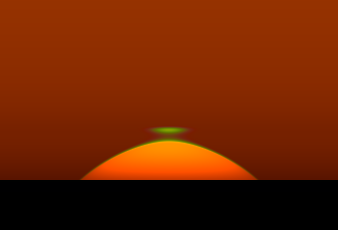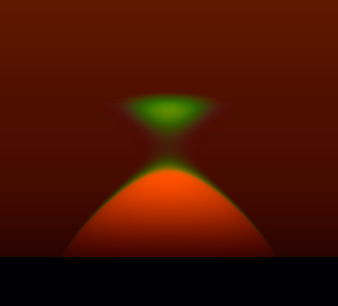Simulations of Green Flashes
Introduction
For the benefit of people who have never seen a green flash, I have
prepared some animated cartoons of a few typical sunsets. Please bear
in mind that these are not very realistic: it is impossible to represent
the true colors of green flashes on a computer monitor; the limited
dynamic range available forces me to show flashes (which are actually
fairly dim, relative to the disk of the Sun) much brighter than
they really are; and many important real-world effects, such as solar
limb-darkening, and the strong extinction gradient near the horizon,
have been ignored to keep the file sizes and download times as small
as possible.
(Slightly more realistic simulations are being added; but these cannot yet
be animated.)
Nevertheless, these animations do show the correct outlines for different
colors of light, given a particular atmospheric model. They suffice to
show how small the “textbook” flash (due simply to isolating the normal
green rim at the horizon) is, and they give a realistic indication of the
progression of each sunset in time.
Scales of space and time
There are really two scales on which important features are to be seen:
The overall view
One is the whole progress of a sunset from beginning to end, with the
premonitory features that tell the experienced green-flash observer what
to expect, and when to look for a flash. As most people will not want to
wait the full two minutes and some seconds required for even the fastest
sunset, these are speeded up by a factor of 17, and pass before your eyes
in less than 10 seconds.
Because of the limited resolution of computer
screens, I have made the images appear a little larger at normal working
distance than the Sun appears in the sky.
If you stand back about 3 meters (10 feet) from the screen, the images
will appear the same size as the Sun does in the sky, and what you see
will correspond roughly to a naked-eye view of the sunset. At normal
viewing distance, the images look bigger — roughly what you would see
through low-power field or “opera” glasses.
The details of a flash
The other scale involves the development of a flash in detail, comparable
to what is seen through
binoculars,
or in photographs taken with telephoto lenses.
In this case, the images are displayed on a scale 3 times larger, which
corresponds roughly to what one sees in binoculars, and in real time (for
a low-latitude observer; those nearer the poles would see a more leisurely
unfolding of events).
The last 8 or 10 seconds of most sunsets is sufficient to
give some idea of the way in which each flash appears, but some cases run
longer. Note that
some
browsers
cannot display these animations at the correct speed.
What you will see
These simulations work best with a black background, so when you move to
the pages where the movies are shown, the text should appear white on
black. Don't panic when your screen goes black at first.
The simulated sunsets take place over the sea, partly because a sea
horizon is favorable, and partly because its simplicity makes the cartoons
simpler and easier to prepare.
Each image is flanked by two vertical scales, calibrated in
minutes of arc.
The horizontal distance between the scales is about 47 minutes of
arc, or 1/73 of a radian; so if you measure the separation of the scales
and multiply by 73, you'll have the distance to stand back from the
screen to see a true naked-eye view of things. If you don't like
multiplying by 73, and are willing to settle for less accuracy,
measure the horizontal diameter of the Sun and multiply by 100.
For example, if the Sun is 3 cm wide on your screen, you should stand back
3 m from the screen to see it “life size.”
The zero-point of these vertical scales is the
astronomical horizon,
marked by a little extra tick. Because the eye must be above the sea,
the apparent horizon
is below the astronomical horizon. The apparent sea
horizon is the boundary between the dark-red sky and the dark-blue sea in
these simulations.
There is also a title displayed with each animated cartoon to identify it.
The title appears for 2 seconds, which may not be enough to read it all
the first time. You probably don't need to read the title anyway; it's
just there as an identifier, and to provide a break between repetitions
of the loop.
The loop should repeat at least 5 times if your browser can display gif
animations. (Some versions of Netscape allow the loop to play over and
over again forever.)
Most of the animation files are between 50 and 100kB long.
Unless you have a very fast connection to the Net, the animation will take
a minute or so to download the first time, during which you can look at
each frame as it loads. The loop plays at correct speed after it has
loaded completely (unless you have one of the Mac versions of Netscape
that fails to insert the proper delay between frames).
Note that the Sun descends vertically in each simulation. That's what an
observer at the Equator would see. The timing of the green flashes is
also correct for an equatorial observer. If you live at even a moderate
latitude and are accustomed to watching sunsets, this will look a bit
odd to you.
What's available
At this stage, only a few sunset “movies” have been produced. Eventually,
there will be more examples. What we have so far are:
This is the model espoused by
Arthur Rambaut,
the younger
Lord Rayleigh,
and many textbook writers; it was rather hesitantly endorsed by
Minnaert,
though I think he had doubts about it. The simulations here
should convince you that this is not how green flashes are formed.
Nevertheless, this model displays the important red (lower) and green
(upper) rims,
whose miraged, magnified images really do appear in some
common flashes. So it's important to understand the “textbook” case,
even though it is not the full explanation of real green flashes.
 This is the flash most commonly seen from near sea level.
Here's a considerably magnified (but fairly realistic) simulation,
showing what such a flash might look like in 8× binoculars.
The animated example
is rather extreme: you are unlikely to see such a large and
pronounced flash yourself. An atmospheric model was chosen to illustrate
the effects about as strongly as they have ever been observed in Nature.
Nevertheless, large flashes are seen occasionally, and this example
makes all the characteristic features easy to see.
This is the flash most commonly seen from near sea level.
Here's a considerably magnified (but fairly realistic) simulation,
showing what such a flash might look like in 8× binoculars.
The animated example
is rather extreme: you are unlikely to see such a large and
pronounced flash yourself. An atmospheric model was chosen to illustrate
the effects about as strongly as they have ever been observed in Nature.
Nevertheless, large flashes are seen occasionally, and this example
makes all the characteristic features easy to see.
This flash is really the green upper limb of the
textbook model, but greatly magnified in the
vertical direction at the
“fold”
where the inverted image of the
inferior mirage
joins the erect image above it.
I also have a page showing how the computed
colors
of inferior-mirage flashes change with varying aerosol extinction.
This is the same as the sunset immediately above, only the frames are run
backwards.
There is a little lead-in of a few seconds of empty sky, so you can see
how the Sun appears unexpectedly with little or no warning at sunrise.
You can see how easy it would be to miss the sunrise flash, especially if
you weren't looking at just the right spot on the horizon.
If you would like to see where the rays go in these mirages, some
ray diagrams are available.
 A mock mirage
is caused by looking down through a
thermal inversion,
and then (thanks to the curvature of the Earth) back out through it again
beyond the horizon. There are simulations of two
mock-mirage
sunsets, one with a
weak thermal inversion, and one with
ducting.
This latter sunset shows a more prominent
red flash
that is shown in detail separately.
(The versions shown here now are more realistic than the ones I showed from
1999 to 2002.)
A mock mirage
is caused by looking down through a
thermal inversion,
and then (thanks to the curvature of the Earth) back out through it again
beyond the horizon. There are simulations of two
mock-mirage
sunsets, one with a
weak thermal inversion, and one with
ducting.
This latter sunset shows a more prominent
red flash
that is shown in detail separately.
(The versions shown here now are more realistic than the ones I showed from
1999 to 2002.)
Like the inferior-mirage flash, the mock-mirage flash is essentially the
green rim, magnified at the transition where erect and inverted images
join. These flashes are best understood by applying
Wegener's principle of cutting the
atmosphere into two parts: one above the observer that produces the green
rim of the setting Sun, and one below eye level that produces the
magnifying mirage at a fixed altitude above the horizon.
When the green rim reaches that magnifying zone, the observer sees a green
flash.
There's also a
page
showing the effects of varying extinction on the colors of mock-mirage flashes.
The results are similar to those for inferior-mirage flashes, as
mentioned above.
 Eventually, other flashes will be added, like the
sub-duct flash
at the left; the polar flash, and the cloud-top flash.
But the ones here already are enough to
give you a notion of what to expect, if you've never seen a green flash.
Eventually, other flashes will be added, like the
sub-duct flash
at the left; the polar flash, and the cloud-top flash.
But the ones here already are enough to
give you a notion of what to expect, if you've never seen a green flash.
Please remember that there are several very different kinds of flash; I
can only simulate the ones I understand. You might see some flashes that
look very different from anything here.
I have also described how the sunset movies were
made, for those with a technical interest in such matters.
© 1999 – 2008, 2012 Andrew T. Young
Back to the
GF home page,
or the
alphabetic index,
or the
Overview page
 This is the flash most commonly seen from near sea level.
Here's a considerably magnified (but fairly realistic) simulation,
showing what such a flash might look like in 8× binoculars.
The animated example
is rather extreme: you are unlikely to see such a large and
pronounced flash yourself. An atmospheric model was chosen to illustrate
the effects about as strongly as they have ever been observed in Nature.
Nevertheless, large flashes are seen occasionally, and this example
makes all the characteristic features easy to see.
This is the flash most commonly seen from near sea level.
Here's a considerably magnified (but fairly realistic) simulation,
showing what such a flash might look like in 8× binoculars.
The animated example
is rather extreme: you are unlikely to see such a large and
pronounced flash yourself. An atmospheric model was chosen to illustrate
the effects about as strongly as they have ever been observed in Nature.
Nevertheless, large flashes are seen occasionally, and this example
makes all the characteristic features easy to see.
 A
A  Eventually, other flashes will be added, like the
sub-duct flash
at the left; the polar flash, and the cloud-top flash.
But the ones here already are enough to
give you a notion of what to expect, if you've never seen a green flash.
Eventually, other flashes will be added, like the
sub-duct flash
at the left; the polar flash, and the cloud-top flash.
But the ones here already are enough to
give you a notion of what to expect, if you've never seen a green flash.